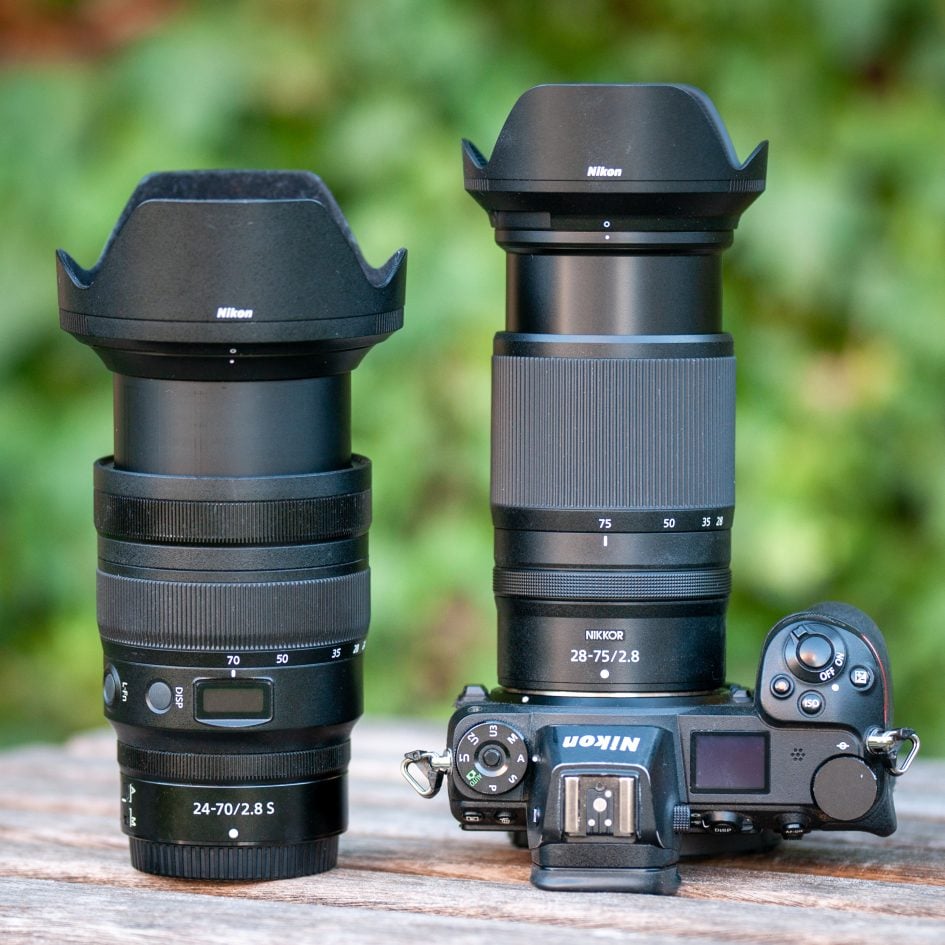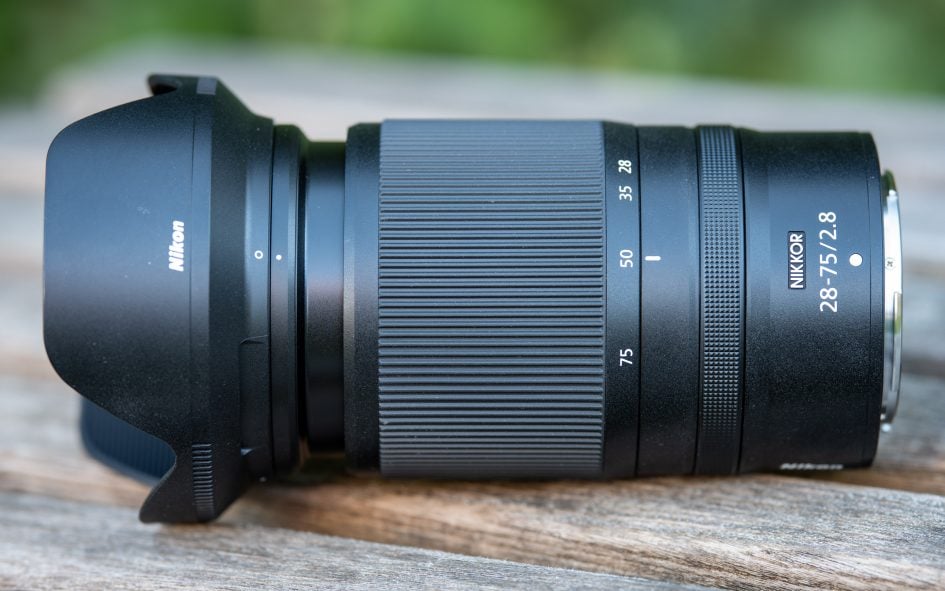Nikon Z 28-75mm f2.8 review
-
-
Written by Thomas
Verdict
The Nikon Z 28-75mm f2.8 is an attractive addition to Nikon’s line of standard zoom lenses: It offers a constant f2.8 aperture at costs only half of Nikon’s professional Z 24-70mm f2.8 S. It’s lightweight and relatively small, has thorough weather sealing and shows convincing performance in the DX image-circle.
What’s not to like? Well, the lens becomes clearly softer towards the full-frame corners and Bokeh in the background is quite nervous. The lens can also produce some nasty ghosting when the light-source is near the middle of the frame. And compared to 24-70mm lenses, it misses-out on 4mm at the short end which restricts the angle-of-view by 9 degrees – which might be a decisive disadvantage for some.
Let’s put this into perspective and have a closer look at how the Nikon Z 28-75mm f2.8 compares to other standard zoom lenses.
Above: Nikon Z 24-70mm f2.8 S (left), Nikon Z 28-75mm f2.8 (right)
Compared to Nikon Z 24-70mm f2.8 S
The Z 24-70mm f2.8 S is Nikon’s professional standard zoom. It performed very well in all of my tests regarding contrast, resolution, focus speed and reliability, colour aberrations, and coma, producing very good image quality. It has additional features compared to the Z 28-75mm f2.8: a useful OLED display, a dedicated focus ring (in addition to the multi-function ring), an AF/MF switch, and a customizable function button. And the Z 24-70mm f2.8 S has the benefit of higher resolution towards the corners plus it is also sharper in close-up shooting. But as Nikon’s new standard zoom costs roughly half of the Z 24-70mm f2.8 S price/performance ratio makes the Z 28-75mm f2.8 a very attractive alternative.
For more details see my Nikon Z 24-70mm f2.8 S review where it came Highly Recommended.
Compared to Nikon Z 24-70mm f4 S
When Nikon introduced their first mirrorless full-frame cameras their kit-lens Z 24-70mm f4 S turned out to be a real surprise: optically very good, almost no loCA, a very usable close-up performance, and capable of retaining its high contrast even in adverse contra-light situations. Its collapsible design and light weight makes it a perfect match for the compact Z-series bodies and its price is a steal (depending on availability of the lens in a kit).
Compared to Nikon’s new Z 28-75mm f2.8 the only drawback of the Z 24-70mm f4S is its relatively ordinary f4.0 focal ratio, but it starts at 24mm giving users a noticeable wider angle of view. And with the exception of the sharpness in the DX image circle the optical quality of the Z 24-70mm f4S is slightly better than from the new Z 28-75mm f2.8: better full-frame corner, better close-up performance, less coma at the short end. So if you want the smallest, lightest, and cheapest standard zoom reaching at least 70mm focal length for your Z-mount camera the Z 24-70mm f4 S is your best bet.
For more details see my Nikon Z 24-70mm f4S review where it earned a Highly Recommended.
Compared to Tamron 28-75mm f2.8 Di III
Nikon seems to have borrowed the optical formula for their new standard zoom from Tamron’s 1st generation 28-75mm f2.8 Di III lens for Sony E-Mount from 2018: The schematics look the same and the MTF-charts are very, very similar. And my test of Nikon’s new lens showed that both lenses perform almost identically – apart from differences which are easily within the range of sample variations. There were really only two aspects where I found some differences in performance: Focus speed of the Nikon lens on a Z7 was faster than the Tamron on a Sony A7R II. And longitudinal color aberrations were a tad lower on the Nikon than on the Tamron. But both observations can be explained by differences in the AF system and color rendering between Sony and Nikon cameras.
So in the end the only real differences between both lenses lie in “packaging”, features, and price: The Nikon just looks and feels like a solid Z-Nikkor which leaves a more robust impression in my hands – on the Tamron the outer shell feels like thin plastic. Nikon also has full weather sealing and added fluorine coating to the front lens for easier cleaning. It also features the standard multi-function ring which can be assigned for manual focus, ISO adjustments, aperture, or exposure compensation. On the Tamron the focus ring does just that: focusing. And the most important technical difference: The Nikon is available in Z-Mount only, the Tamron in E-Mount only. You may think about using an E-to-Z mount converter to use the Tamron on a Nikon body. But as far as I know the currently available mount converters either implement only part of the communication protocol between a Z-Nikkor and a Nikon Z body or they simply infringe on Nikon’s patents. In any case I’d rather wait for Tamron (and Sigma) to come to an agreement with Nikon to produce Z-Mount versions of their lenses.
For more details see my Tamron 28-75mm f2.8 Di III review where it earned a recommendation.
Nikon Z 28-75mm f2.8 final verdict
The Nikon Z 28-75mm f2.8 is a valuable addition to Nikon’s Z-Mount line-up, that’s wisely pitched between their entry-level Z 24-70mm f4 S kit zoom and the high-end Z 24-70mm f2.8 S. The new lens can keep up with its older siblings in the DX image-circle and delivers very usable close-up performance too. It’s small and light and comes at a reasonable price that makes it a viable option for those who can only dream of f2.8 zooms and were otherwise heading to the budget kit lens. For the price, the sharpness unsurprisingly becomes softer in the full-frame corners and many will miss the wider coverage of zooms that start at 24mm; there’s also some irritating flare and ghosting under certain circumstances. I also wonder, since the lens is clearly based on the Tamron 28-75mm f2.8, why didn’t Nikon use the optical design of the latest 2nd generation (G2) version which recently hit the streets and is a clear improvement over their G1 design? But all-in-all the Nikon Z 28-75mm f2.8 is an attractive option for Z-mount owners and I’m happy to award Nikon’s new standard zoom lens a recommendation!
Good points:
- Constant f2.8 focal ratio.
- Small and light.
- Very good resolution and contrast in the DX image circle.
- Good black levels in contra-light situations.
- Very usable close-up performance.
- Relatively low price.
- Reliable and fast AF operation.
- Full weather sealing plus fluorine coating.
Bad points:
- Not so sharp outside the DX image circle with soft full-frame corners.
- Strong flare/ghosting with light source near the middle.
- Wide end starts at 28mm focal length, not 24mm.






